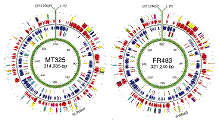Virology, Nebraska Center for
Document Type
Article
Date of this Version
December 1992
Abstract
Levels of human immunodeficiency virus (HIV) DNA, RNA, or p24 antigen and reverse transcriptase activity in T-cell cultures treated with 500 IU of recombinant alpha interferon (rIFNα) per ml were comparable to those in control cultures. Radioimmunoprecipitation analysis of proteins in lysates of IFN-treated T cells documented a marked accumulation of HlV proteins. Localization of gp120 by immunofluorescence showed a diffuse pattern in IFN-treated cells quite distinct from the ring pattern in untreated control cells. That large quantities of a120 in aberrant cell compartments might affect HlV morphogenesis was confirmed in infectivity studies: virions from IFN-treated cells were 100- to 1,000-fold less infectious than an equal number of virions from control cells. Direct examination of IFN-treated and control HW-infected cells by transmission electron microscopy showed little difference in the number or distribution of viral particles. However, quantitation of a120 by immunogold particle analysis revealed a marked depletion of envelope glycoprotein in virions released from IFN-treated cells. This defect in gp120 assembly onto mature viral particles provides a molecular basis for this loss of infectivity.


Comments
Published in JOURNAL OF VIROLOGY, Dec. 1992, p. 7543-7548, Vol. 66, No. 12, 0022-538X921127543-06$02.00/0 Copyright © 1992, American Society for Microbiology. Used by permission.